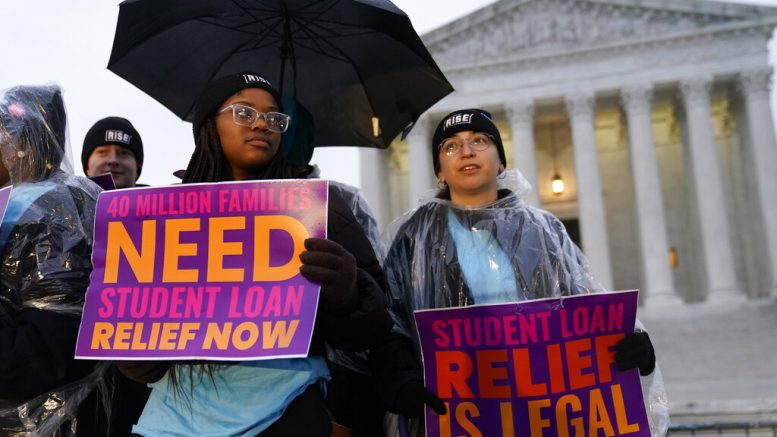WASHINGTON (AP) — The Supreme Court is taking up a partisan legal fight over President Joe Biden’s plan to wipe away or reduce student loans held by millions of Americans.
The high court, with its 6-3 conservative majority, is hearing arguments on Tuesday in two challenges to the plan, which has so far been blocked by Republican-appointed judges on lower courts.
Arguments are scheduled to last two hours but likely will go much longer. The public can listen in on the court’s website.
Twenty-six million people have applied, and 16 million have been approved to have up to $20,000 in federal student loans forgiven, the Biden administration says. The program is estimated to cost $400 billion over 30 years.
“I’m confident the legal authority to carry that plan is there,” Biden said on Monday, at an event to mark Black History Month.
The president, who once doubted his own authority to broadly cancel student debt, first announced the program in August. Legal challenges quickly followed.
Republican-led states and lawmakers in Congress, as well as conservative legal interests, are lined up against the plan as a clear violation of Biden’s executive authority. Democratic-led states and liberal interest groups are backing the Democratic administration in urging the court to allow the plan to take effect.
Without it, loan defaults would dramatically increase when the pause on loan payments ends no later than this summer, the administration says. Payments were halted in 2020 as part of the response to the coronavirus pandemic.
The administration says a 2003 law, commonly known as the HEROES Act, allows the secretary of education to waive or modify the terms of federal student loans in connection with a national emergency. The law was primarily intended to keep service members from being worse off financially while they fought in wars in Afghanistan and Iraq.
Nebraska and other states that sued say the plan is not necessary to keep the rate of defaults roughly where it was before the pandemic. The 20 million borrowers who have their entire loans erased would get a “windfall” that will leave them better off than they were before the pandemic, the states say.
Dozens of borrowers came from across the country to camp out near the court on a soggy Monday evening in hopes of getting a seat for the arguments. Among them was Sinyetta Hill, who said that Biden’s plan would erase all but about $500 of the $20,000 or so she has in student loans.
“I was 18 when I signed up for college. I didn’t know it was going to be this big of a burden. No student should have to deal with this. No person should have to deal with this,” said Hill, 22, who plans to study law after she graduates from the University of Wisconsin-Milwaukee in May.
Biden’s plan could meet a frosty reception in the courtroom. The court’s conservatives have been skeptical of other Biden initiatives related to the pandemic, including vaccine requirements and pauses on evictions. Those were billed largely as public health measures intended to slow the spread of COVID-19.
The loan forgiveness plan, by contrast, is aimed at countering the economic effects of the pandemic.
The national emergency is expected to end May 11, but the administration says the economic consequences will persist, despite historically low unemployment and other signs of economic strength.
In addition to the debate over the authority to forgive student debt, the court also will confront whether the states and two individuals whose challenge also is before the justices have the legal right, or standing, to sue.
Parties generally have to show that they would suffer financial harm and benefit from a court ruling in their favor. A federal judge initially found that the states would not be harmed and dismissed their lawsuit before an appellate panel said the case could proceed.
Of the two individuals who sued in Texas, one has student loans that are commercially held and the other is eligible for $10,000 in debt relief, not the $20,000 maximum. They would get nothing if they win their case.
A decision is expected by late June.




































